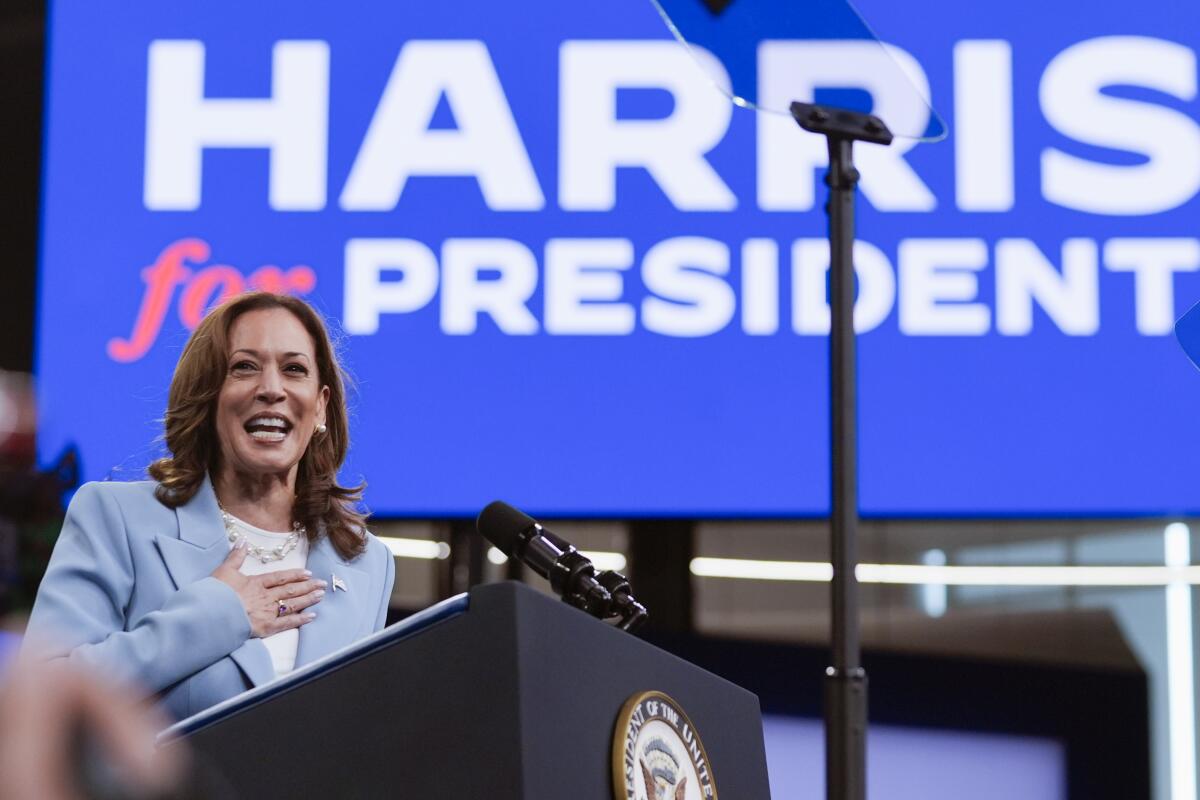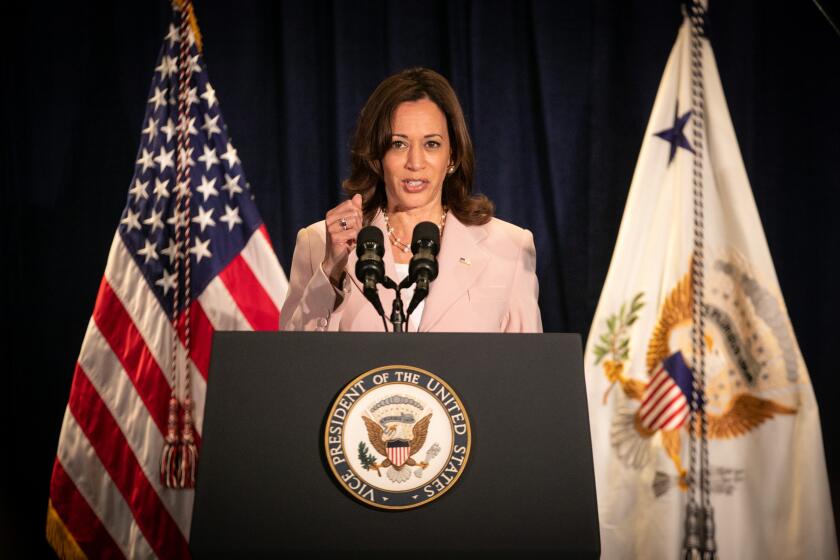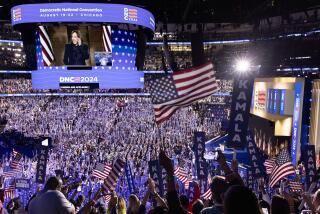DNC says Harris has a delegate majority. This is how its virtual roll call process works

- Share via
WASHINGTON — Vice President Kamala Harris has secured enough delegates to become the Democratic presidential nominee, according to Democratic National Committee Chairman Jaime Harrison, but it’s not time for the balloon drop just yet.
Harrison made the announcement Friday, but neither the DNC nor the Harris campaign provided a comprehensive vote tally.
Delegates to the Democratic National Convention began officially selecting their nominee for president in a process that kicked off Thursday. But unlike in past years, they are not doing so in the raucous party atmosphere of the convention floor or even during the convention itself. Instead, they are filling out electronic ballots at their homes, offices or vacation spots more than two weeks before the first delegate sets foot inside Chicago’s United Center.
Harris was the only candidate eligible to receive votes after no other candidate qualified by a Tuesday night deadline. She’s looking to officially claim the nomination Monday evening when the DNC is expected to release final results. That’s just 15 days after President Biden announced he would not seek a second term following concerns within the party over his ability to defeat Republican nominee Donald Trump in November.
How does the virtual process work?
Nearly 4,700 delegates are using an electronic voting method the party says is similar to one used to tally virtual roll call votes in the 2020 convention, when the COVID-19 pandemic forced the party to conduct much of its official business remotely.
Under new procedures adopted by the convention’s rules committee in late July, candidates had until Tuesday to declare their intent to seek the nomination and until that night to submit the 300 delegate signatures required to qualify for the roll call vote. According to a DNC statement, Harris submitted signatures from 3,923 delegates, about 84% of the full delegation and 99% of delegates who signed a petition.
Any vote cast for someone other than Harris in the roll call will be counted as “present.”
The voting concludes at 3 p.m. Pacific time Monday.
Who gets to vote?
Among those voting are pledged delegates selected through state primaries and caucuses as well as more than 700 others who have automatic delegate slots by virtue of the elected office or party positions they hold. These include Democratic governors, U.S. senators and representatives, former presidents and DNC members.
These automatic delegates, known informally as superdelegates, were the subject of much debate within the party for years because of their potential to influence the outcome of a close nomination fight despite not having been selected for their posts through a public process. Historically, however, superdelegates have never backed a candidate for the nomination other than the one who also earned the majority of pledged delegates.
In a tumultuous stretch of the 2024 presidential campaign, donors contributed hundreds of millions of dollars to Vice President Harris and former President Trump.
After the 2016 election, the party adopted changes that allowed superdelegates to vote only on the second and subsequent ballots. Party rules allow superdelegates to vote on the first ballot if a candidate has either won a majority of pledged delegates through the primary and caucus process, as Biden did, or submitted the signatures of a majority of total delegates, as Harris did.
What will the result look like?
The DNC said it would announce final, state-by-state results after voting concludes Monday. That’s a departure from how presidential roll calls are usually conducted by either party. In past conventions, roll call votes were tallied in real time before a national audience, with state delegations announcing their votes from the convention floor or, in the case of the 2020 Democratic convention, through remote video presentations.
What about the nominee for vice president?
Once Harris officially wins the nomination, the new convention rules allow her to place the name of her pick for vice president into nomination, at which point the convention chair can declare that candidate as the vice presidential nominee.
Why is this happening before the convention?
DNC officials first indicated in May that they would conduct a virtual roll call to clear a potential hurdle in getting the Democratic nominee on the ballot in Ohio. The state’s deadline to file for the general election ballot is Aug. 7, two weeks before Democratic delegates would have crowned the nominee at the convention.
Although the deadline had been modified in previous presidential election years to accommodate late-summer conventions of both parties, this year state Republicans initially planned to enforce the existing deadline, with one GOP lawmaker calling the scheduling bind “a Democratic problem.”
The Republican-controlled Legislature eventually made the change at the behest of Republican Gov. Mike DeWine, but the law does not go into effect until Aug. 31. Citing concerns that Ohio Republicans could still try to block their candidate from getting on the ballot, DNC officials decided to move forward with their virtual roll call as originally planned.
What about the speeches and balloons?
Party officials say they will hold a ceremonial roll call vote during the convention, mimicking the ritual of state delegations announcing their votes from the convention floor with much fanfare.
More to Read
Get the L.A. Times Politics newsletter
Deeply reported insights into legislation, politics and policy from Sacramento, Washington and beyond. In your inbox three times per week.
You may occasionally receive promotional content from the Los Angeles Times.











